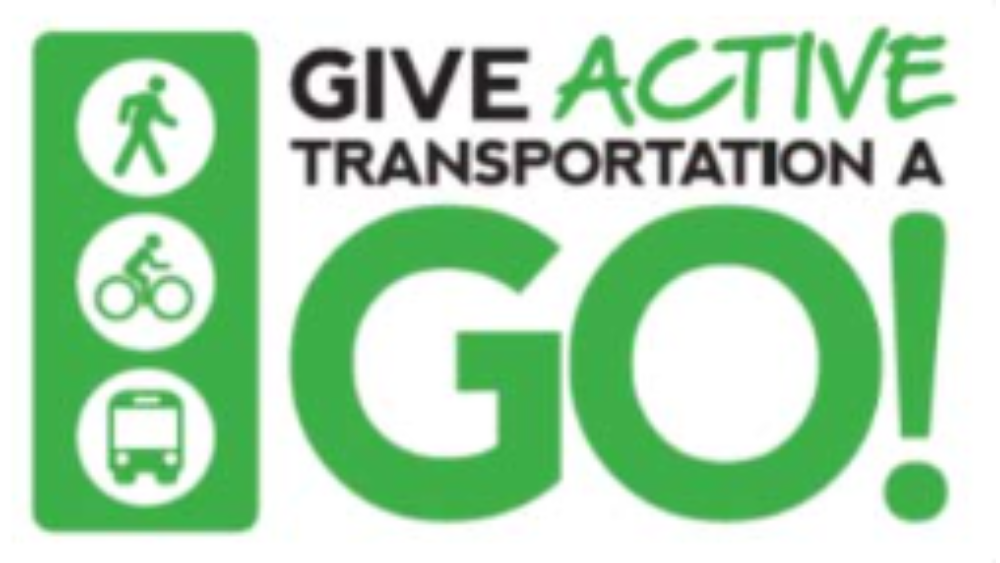Active Transportation
Active transportation (AT) is any form of human powered transportation that gets you to and from work, school, shopping, appointments, recreation, visiting friends, etc.1 In other words, AT is ‘physical activity’ with ‘purpose’. Walking and cycling are the most popular forms of AT and are often combined with other travel modes such as public transit.
The Problem…
Physical activity is good for health at all ages yet only 49% of Canadian adults achieve the recommended amount of 150 minutes per week and 44% of children and youth achieve the recommended 60 minutes per day according to Canada's 24-Hour Movement Guideline. 2
Active Transportation can be part of the solution!
Active transportation is a way to make physical activity a regular part of everyday life. It is also good for mental health, overall well-being, safety, the environment, and the economy.1,3,4
Benefits of Using Active Transportation
- Positive mental health
- Reduced stress
- Reduced risk of several chronic diseases
- Improved fitness
- Improved productivity at school and work
- Reduced motor vehicle-related injuries and deaths
- Improved air quality
- Reduced greenhouse gas emissions
- Reduced spending on gas and parking
- Improved social connections
Active Commuting
What is active commuting? Active commuting is about using active transportation (AT) - walking, cycling or public transit - to get to and from work. Most people travel to / from work using motorized transportation. For some commuters it may be possible to use AT for part or all of their commute. There are numerous benefits to active commuting, and they all start with thinking outside the car!12
Why Give Active Commuting a Go
- Time: Finding time to fit physical activity into a day can be a challenge for many. The good news is that active commuting can help by building physical activity into a daily routine rather than trying to find time to fit it in.
- Money: Driving less can also lead to personal cost savings which is good for personal economic health.
- Environment: Thinking outside the car and actively commuting also provides environmental benefits, such as improved air quality, reduced greenhouse gas emissions, and less traffic congestion on the roads.
Cycling
Whether using London’s Thames Valley Parkway, designated bicycle routes, or city roads, cycling is an excellent way of fitting physical activity into your daily life!
Remember - bicycles are considered vehicles under Ontario’s Highway Traffic Act and are expected to follow the rules of the road. When sharing the road, drivers and cyclists need to be respectful and courteous.
Did you know?
- Cycling provides a moderately intense workout which can provide the recommended amount of weekly exercise.1
- It’s faster than you think. It takes 30 minutes or less to cycle 5 km.2
- Physical activity health benefits gained by cycling far outweigh the health risks posed by the increased exposure to air pollutants.34
- All LTC buses have bike racks that hold two bikes at a time. Learn how to use a LTC bus bike rack.
Walking
Walking allows you to experience and appreciate your environment in new ways and to make discoveries that are not possible when using other types of transportation.
Did you know?
- Both brisk and leisurely walking can help you meet Canada's 24-Hour Movement Guidelines, support healthy ageing and can provide a variety of physical and mental health benefits.1
- Walkable neighbourhoods with destinations that are close, well-connected streets and adequate green space, can increase physical activity levels of people who live there.3,4,5
Want your child(ren) to walk to school? Try active school travel!
Active & Safe Routes to School (ASRTS)
ASRTS Newsletter supports active and safe travel for children by providing information about upcoming events, contests, grants, and more. Sign up today to hear about the great work that is being done in our community that supports physical and mental health, reduces traffic and enhances safety around schools, improves air quality, and benefits the environment.
ASRTS is a community partnership across Elgin, Oxford and Middlesex Counties and the cities of London and St. Thomas. They work together to encourage children and families to choose active transportation.
School Travel Planning (STP) is their primary program that encourages active transportation to and from school by developing an action plan to build upon strengths and work to remove concerns around the school.
Public Transit
Active transportation (AT) includes the use of public transit such as bus, bus rapid transit, subway, train, light rail transit, because every trip begins and / or ends with a walk or a bike ride. All City of London buses have bike racks for those who cycle and want to place their bike on the bus for part of their journey.
Using public transit has numerous benefits, including:1,2,3,4
- Health: Individuals who use public transit are more physically active, have higher fitness levels, better cardio-respiratory health, reduced risk of developing Type 2 Diabetes, reduced cancer risk as well as stronger muscles and bones. Being physically active can also improve mental health by boosting self-esteem and reducing the incidence of stress, depression and other mental health conditions.
- Safety: Motor vehicle collisions are responsible for unnecessary injuries and deaths of drivers, pedestrians and cyclists. Using public transit instead of a personal motor vehicle is one of several ways to reduce traffic congestion and improve road safety.
- Environment: When more people use public transit instead of a personal motor vehicle, automobile exhaust as well as greenhouse gas emissions are reduced. This is particularly true for electric powered transit vehicles. Improved air quality also helps to reduce associated cardiovascular and respiratory illnesses and deaths.
- Economic: Riding the bus instead of driving a car can result in substantial cost savings.
- Equity: Using public transit can be an effective means of travel that provides equitable access to work, school, and various services for those who don’t have access to a personal motor vehicle for various reasons: health, age, ability, economic, and personal choice.
Community Design & Active Transportation
The design of neighbourhood streets, buildings and facilities can influence everyday transportation choices and makes it easier for people of all ages and abilities to live active lifestyles.
For more information about community design, visit here.
Get moving with Active Transportation as part of a healthy lifestyle!
Resources
- Bicycles on Sidewalks
- CAA - Cycling
- Canada Walks
- City of London Bike Routes and Walking Trails
- City of London Cycling
- City of London Mobility Master Plan
- City of London Walking
- Cycling and the Law
- Google Maps
- London’s Bus Rapid Transit Initiative
- London Transit Bike and Ride
- London Transit Customer Service Line (519-451-1347)
- London Transit
- Middlesex County Connect Inter-Community Transit
- Middlesex County Trails Guide
- Ministry of Transportation - Bicycle Safety
- Multi-Use Paths
- ParticipACTION
- Road Safety
- Rules of the Road
- Walk Score
- Winter Walking Brochure
References
https://www.ualberta.ca/kinesiology-sport-recreation/media-library/research/centres-and-units/centre-for-active-living/2017-active-transportation-factsheet-rev.pdf
https://www150.statcan.gc.ca/n1/daily-quotidien/210901/dq210901c-eng.htm//www.canada.ca/content/dam/phac-aspc/documents/services/publications/health-promotion-chronic-disease-prevention-canada-research-policy-practice/vol-37-no-8-2017/ar-04-eng.pdf
https://res.cloudinary.com/capeacme/image/upload/v1522366665/2.Report_-_Prescribing_Active_Travel_for_Healthy_People_and_a_Healthy_Planet_-_A_Toolkit_for_Health_Professionals.pdf
https://www.canada.ca/en/public-health/services/publications/chief-public-health-officer-reports-state-public-health-canada/2017-designing-healthy-living.html#a5_1
Last modified on: April 4, 2025






